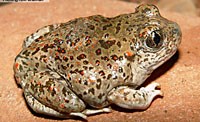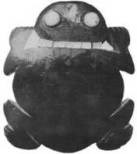|
The requested video is no longer available.

Photo courtesy of Gary Nafis The mating call of the Mexican spadefoot toad is only heard during the summer monsoon season. For most of the year, this animal lays buried beneath the sands of Chaco's arid landscape; the toads can survive underground for over a year if necessary. When the heavy rains of July and August form small, temporary pools of water, the toads rehydrate in the nearest puddle and eat voraciously. The males begin calling for the females while floating on the water. The female lays over 1,000 eggs. 
Courtesy of the American Museum of Natural History In 42 to 48 hours, the tadpoles emerge and begin feeding. Their only chance of survival is to develop into a frog before the puddle dries up. In one of the fastest development rates for all amphibians, Mexican spadefoot toads metamorphosize from tadpole to juvenile in two to three weeks. As the pools of water dry, the juveniles move away and continue to feed at night, burrowing into the sand or under rocks during the day. Like the adults, the juveniles stay in a summer burrow and feed at night as long as the rainy season continues. Eventually, both adults and juveniles will dig a winter burrow and stay there until the next summer's rainy season begins. The calls of these toads would have been celebrated by the Ancestral Puebloan people living in Chaco Canyon 1,000 years ago. These amphibians are revered creatures. They are a symbol of life-giving rain, a blessing from the ancestors. Archaeologists found scores of frogs carved out of jet and turquoise buried in the rooms of Pueblo Bonito and other Great Houses. |
Last updated: February 24, 2015
